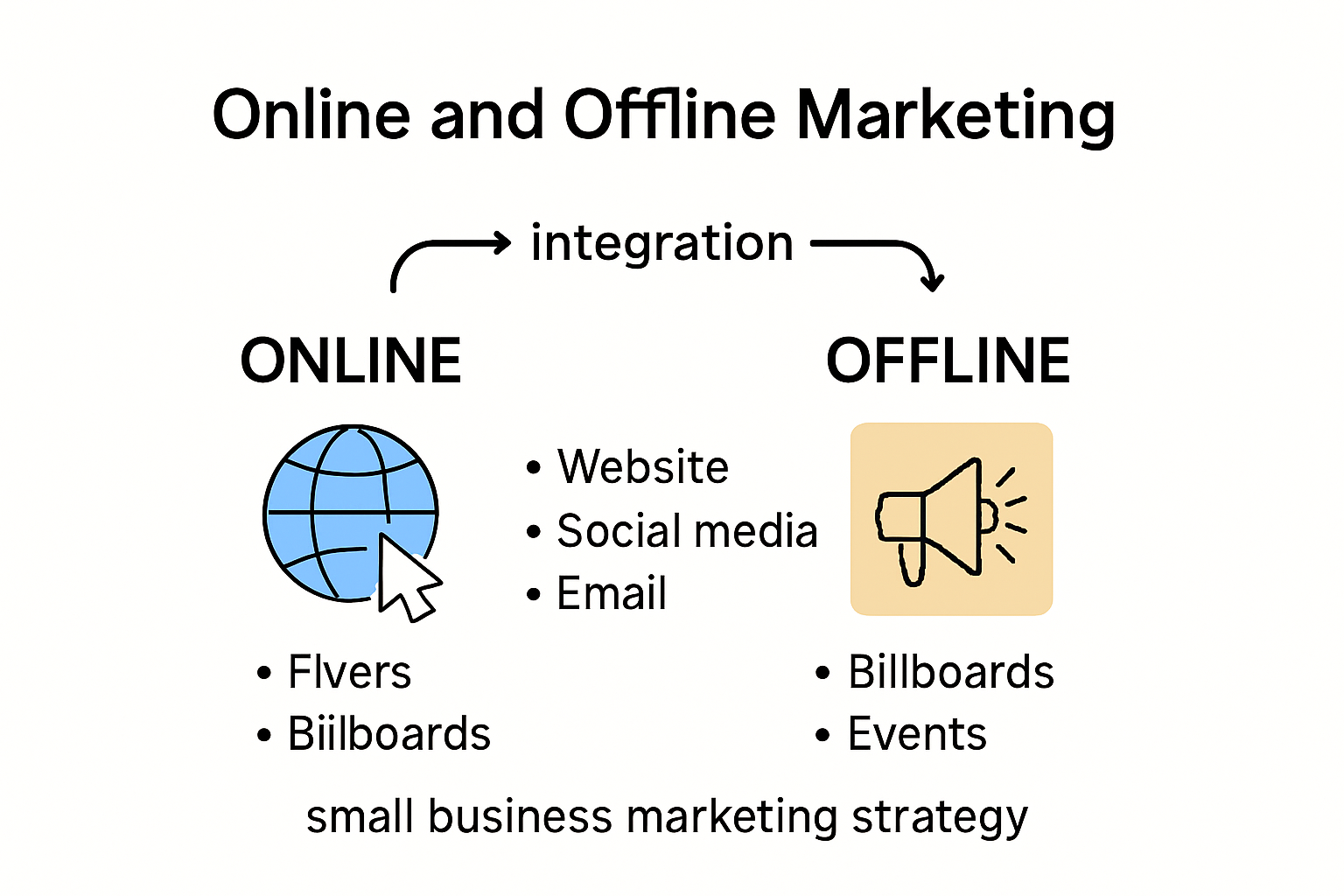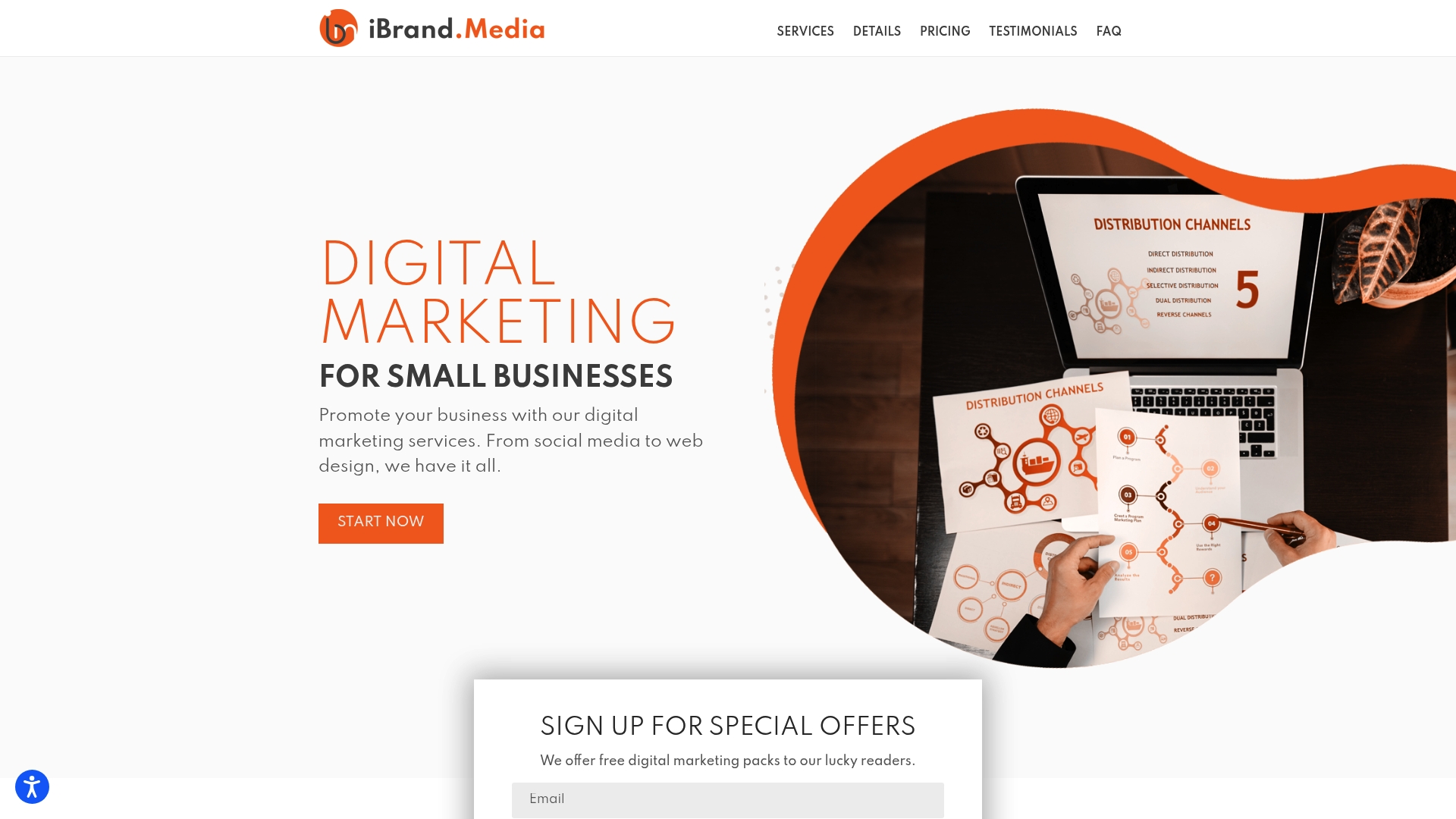Small businesses keep hearing that online marketing is the ticket to growth and offline efforts are old news. But in 2025 that separation is fading fast. While digital tactics get all the attention, a Seattle bookstore boosted its revenue by an incredible 300% when it combined online and offline strategies. It turns out, mixing both worlds does not dilute your impact. It multiplies it.
Table of Contents
- Why Balance Online And Offline Marketing
- Key Strategies For Blending Online And Offline Efforts
- Tools And Tips For Tracking Combined Success
- Real-World Examples And Industry Insights
Quick Summary
| Takeaway | Explanation |
|---|---|
| Balance online and offline marketing | Small businesses must integrate both approaches for effective marketing strategies. |
| Create integrated customer touchpoints | Use strategies that allow smooth transitions between online and offline interactions for an engaging experience. |
| Leverage data for cross-channel marketing | Collect and analyze customer data to personalize campaigns across different platforms effectively. |
| Implement advanced tracking methods | Utilize unique tracking codes and custom landing pages to correlate offline efforts with online engagement. |
| Study real-world success stories | Learn from businesses that successfully blend online and offline strategies to inspire your own marketing efforts. |
Why Balance Online and Offline Marketing
Small businesses face a critical challenge in 2025: creating a cohesive marketing strategy that effectively leverages both online and offline channels. Balancing online and offline marketing is not just a tactical choice but a strategic necessity for sustainable business growth.
The Complementary Nature of Marketing Channels
Modern consumers interact with brands through multiple touchpoints, making an integrated approach essential. Research from Sophia University reveals that offline promotional media like printed coupons significantly increase cognitive engagement and consumer behavioral responses. This demonstrates that traditional marketing methods still hold substantial value in driving customer interactions.
Digital technologies have transformed business operations, but they haven’t eliminated the power of personal connections. Our comprehensive guide on marketing strategies explores how different channels can work together to amplify a business’s reach and impact.
Strategic Integration for Enhanced Performance
A study published in the journal Sustainability highlights that small and medium-sized enterprises investing in digital technologies experience enhanced operational efficiency and improved customer services. However, this doesn’t mean abandoning offline strategies. Instead, it suggests creating a synergistic approach that combines digital innovation with traditional marketing techniques.
Consider how offline stores can drive online sales by providing physical experiences that build trust and engagement. The Journal of Marketing Research notes that physical interactions can significantly influence online purchasing behaviors. This means a local storefront can generate digital leads, while online platforms can direct customers to physical locations.
Crafting a Holistic Marketing Ecosystem
Successful marketing in 2025 requires businesses to view online and offline channels not as competing strategies, but as interconnected components of a comprehensive marketing ecosystem. By understanding each channel’s unique strengths and integrating them seamlessly, small businesses can create more robust, responsive, and effective marketing approaches.
Key considerations include:
- Consistent Branding: Ensure your messaging and visual identity remain uniform across all platforms
- Multichannel Customer Experience: Design strategies that allow smooth transitions between online and offline interactions
- Data-Driven Insights: Use analytics from both digital and traditional marketing to refine your overall approach
Balancing online and offline marketing is about creating a flexible, adaptive strategy that meets customers where they are most comfortable. It’s not about choosing one method over another, but orchestrating a harmonious marketing symphony that resonates with your target audience.

Key Strategies for Blending Online and Offline Efforts
Successful small businesses in 2025 recognize that blending online and offline marketing efforts requires strategic planning, creativity, and a deep understanding of customer engagement dynamics. Developing a cohesive approach that seamlessly connects digital and physical marketing channels can significantly enhance brand visibility and customer experience.
Creating Integrated Customer Touchpoints
The key to effective marketing integration lies in developing interconnected touchpoints that provide a consistent and engaging brand experience. Research from MDPI Encyclopedia emphasizes the importance of creating strategies that allow customers to move effortlessly between online and offline interactions.
For instance, businesses can implement QR codes on physical marketing materials that direct customers to online platforms, or use in-store displays that showcase digital content. Our comprehensive local marketing guide provides deeper insights into creating these seamless connections.

Data-Driven Cross-Channel Marketing
A comprehensive research paper highlights the critical role of data in blending online and offline marketing efforts. Small businesses can leverage customer data to create more personalized and targeted marketing approaches across different channels.
Strategic data collection and analysis allow businesses to:
- Track Customer Interactions: Monitor how customers move between online and offline touchpoints
- Personalize Marketing Messages: Develop targeted campaigns that resonate across multiple platforms
- Optimize Marketing Spend: Identify the most effective channels for reaching specific customer segments
Technological Integration and Customer Experience
Advanced technologies now enable more sophisticated integration of online and offline marketing efforts. Businesses can use tools like:
- Mobile apps that provide in-store digital experiences
- Augmented reality features that bridge physical and digital spaces
- Location-based marketing that connects online targeting with offline interactions
The goal is to create a fluid, omnichannel experience that feels natural and convenient for customers. This approach goes beyond simply using multiple channels it involves creating a cohesive ecosystem where online and offline marketing work together harmoniously.
Implementing these strategies requires careful planning and a willingness to experiment. Small businesses should start by identifying their unique customer journey, understanding where online and offline touchpoints can be most effectively integrated, and continuously refining their approach based on customer feedback and performance data.
Ultimately, blending online and offline marketing is about creating a more holistic, responsive, and customer-centric approach to business promotion. By breaking down the barriers between digital and physical marketing, small businesses can develop more engaging, effective strategies that meet the evolving expectations of modern consumers.
Tools and Tips for Tracking Combined Success
Tracking the effectiveness of integrated online and offline marketing efforts requires sophisticated strategies and advanced analytical tools. Small businesses must develop comprehensive approaches that provide clear insights into their marketing performance across multiple channels.
Advanced Tracking Methodologies
Marketing Evolution emphasizes the importance of gathering the right data and leveraging marketing analytics platforms to understand the complete customer journey. Businesses can implement several innovative tracking techniques to correlate offline and online marketing efforts.
Effective tracking methods include:
- Unique Tracking Codes: Create campaign-specific URLs and QR codes
- Dedicated Phone Numbers: Use different contact numbers for offline and online campaigns
- Custom Landing Pages: Design specific web pages for offline marketing initiatives
Our guide on generating website leads provides additional insights into creating trackable marketing touchpoints.
To help you compare and choose appropriate tracking methods, here’s a summary table of popular online and offline marketing tracking tools and their purposes:
| Tracking Method | Purpose | Example Use Case |
|---|---|---|
| Unique Tracking Codes | Track source and campaign effectiveness | Printed QR code on flyer |
| Dedicated Phone Numbers | Attribute leads/calls to specific campaigns | Unique number on direct mail postcard |
| Custom Landing Pages | Measure responses to offline promotions | In-store poster with special URL |
| Event-Specific Hashtags | Monitor engagement across social media | Conference banner with branded hashtag |
| Promotional Codes | Link purchases to marketing initiatives | Coupon code from magazine ad |
Integrating Digital and Physical Metrics
Search Engine Journal recommends using strategic tracking mechanisms like:
- Event-specific hashtags
- Unique promotional codes
- Cross-channel conversion tracking
These techniques allow businesses to link offline activities directly to online engagement metrics, providing a more comprehensive view of marketing performance.
Technology-Enabled Performance Measurement
HubSpot’s marketing analytics platform demonstrates how technology can unify tracking across different marketing channels. Advanced tools now enable businesses to:
- Consolidate data from multiple sources
- Create comprehensive customer interaction maps
- Generate real-time performance reports
- Identify most effective marketing touchpoints
Small businesses should focus on selecting tools that offer flexibility, integration capabilities, and user-friendly interfaces. The goal is to create a seamless system that provides actionable insights without overwhelming management with complex data.
Successful tracking requires a holistic approach that goes beyond simply collecting numbers. Businesses must interpret data contextually, understanding how different marketing efforts influence customer behavior and contribute to overall business objectives.
Remember that tracking is an ongoing process. Regularly review and refine your measurement strategies, remain open to new technologies, and continuously adapt your approach based on emerging marketing trends and customer behaviors. By maintaining a flexible and data-driven mindset, small businesses can optimize their marketing efforts and achieve more meaningful results across online and offline channels.
Real-World Examples and Industry Insights
Real-world case studies provide invaluable insights into the practical application of integrated online and offline marketing strategies. By examining successful businesses that have effectively blended digital and traditional approaches, small business owners can gain actionable strategies and inspiration for their own marketing efforts.
Resilience Through Digital Adaptation
Research analyzing Uber Eats data during the COVID-19 pandemic revealed how small restaurants successfully navigated challenging business environments by leveraging digital channels. These businesses demonstrated remarkable adaptability by quickly transitioning to online platforms, maintaining customer connections, and creating new revenue streams.
The pandemic accelerated digital transformation, forcing businesses to rethink their marketing approaches. Restaurants that integrated online ordering systems, developed robust social media presence, and created engaging digital experiences were able to sustain and even grow their customer base during unprecedented challenges.
Our guide on social media marketing strategies offers additional insights into developing effective digital engagement approaches.
Local Business Transformation Success Stories
A compelling case study of a Seattle bookstore illustrates the potential of integrated marketing strategies. Facing a 60% sales decline over five years, the bookstore implemented a hybrid business model that combined online and offline approaches. By creating an engaging online presence while maintaining their physical storefront, they achieved a remarkable 300% revenue increase.
Key strategies employed by this bookstore included:
- Virtual Book Clubs: Hosting online events that connected with in-store customers
- Personalized Online Recommendations: Leveraging customer data to provide tailored suggestions
- Seamless Online-Offline Purchase Options: Enabling customers to browse online and pick up in-store
The following table summarizes the key strategies that led to the Seattle bookstore’s 300% revenue growth and their effects:
| Strategy | Description | Impact |
|---|---|---|
| Virtual Book Clubs | Online events engaging local customer base | Increased customer loyalty & retention |
| Personalized Online Recommendations | Tailored suggestions using customer data | Higher conversion rates, improved CX |
| Online-Offline Purchase Options | Browse online, pick up in-store (hybrid) | Greater convenience, increased foot traffic |
Industry-Wide Marketing Evolution
Successful businesses across various sectors are recognizing the importance of integrated marketing approaches. Industries ranging from retail and hospitality to professional services are developing innovative strategies that blur the lines between online and offline experiences.
Common characteristics of successful integrated marketing include:
- Consistent brand messaging across all channels
- Personalized customer experiences
- Flexible engagement options
- Data-driven decision making
These examples demonstrate that successful marketing in 2025 is not about choosing between online and offline strategies, but about creating a cohesive, adaptable approach that meets customers where they are most comfortable.
Small businesses can learn from these insights by:
- Remaining open to technological innovations
- Continuously experimenting with new marketing approaches
- Listening to customer feedback
- Investing in tools that enable seamless channel integration
The future of marketing lies in understanding and responding to customer preferences with agility, creativity, and a willingness to embrace both digital and traditional approaches. By studying successful examples and remaining adaptable, small businesses can develop marketing strategies that drive growth and customer loyalty.
Frequently Asked Questions
What is the importance of balancing online and offline marketing for small businesses?
Balancing online and offline marketing is crucial for small businesses as it creates a cohesive strategy that enhances brand visibility, improves customer engagement, and leverages the strengths of both channels for better overall performance.
How can small businesses create integrated customer touchpoints?
Small businesses can create integrated customer touchpoints by using strategies like QR codes on physical materials, combining in-store displays with digital content, and ensuring a consistent messaging experience across all platforms.
What data analytics methods should small businesses use for cross-channel marketing?
Small businesses should leverage data analytics methods such as tracking customer interactions, personalizing marketing messages based on data insights, and optimizing marketing spend by analyzing the performance of various channels.
Can you provide examples of successful small businesses blending online and offline marketing?
One example is a Seattle bookstore that increased its revenue by 300% by combining online and offline strategies, such as hosting virtual book clubs, offering personalized online recommendations, and allowing customers to browse online and pick up in-store.
Ready to Bridge Your Online and Offline Marketing?
Are you struggling to give equal power to your online and offline marketing? Many small business owners share the same challenge. The article highlighted how critical it is to create seamless customer touchpoints and track your efforts across every channel for real growth. If building these connections or tracking real results feels overwhelming, you are not alone. Explore how other businesses, like the Seattle bookstore, found success by uniting their strategies. See how your business can achieve the same impact. Visit our Uncategorized section for helpful guidance.

Let ibrand.media help you build a powerful blend of digital marketing, from SEO optimization to real-time performance tracking. Work with experts who understand your local market and can craft a plan that connects your online campaigns to real-world results. Do not wait while competitors move ahead. Take your next step today at https://ibrand.media.

Recent Comments